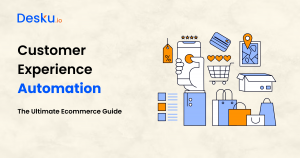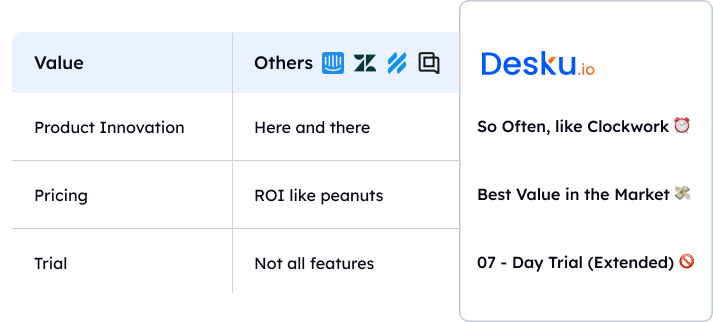Customer engagement is always a challenge considering any business type. Well, there are lots of questions considering customer engagement, how to do it, how to implement it, and whatnot?!
But the first thing that flows into our minds when it comes to improving customer relations is customer support services rather than customer engagement. It is insufficient to encourage customers and ask them to splurge more with your brand. This could make them feel unworthy and transactional to your company.
Instead, you should improve the customer experience to boost loyalty with the help of a successful customer engagement strategy. However, you need to be clear with one thing: that you value customer relationships with the buyers, not with the penny they splurge on your brand. That’s the main reason why you should consistently engage customers and tell them about your product according to their needs.
Speaking of the stats, 62 per cent of customers say that their experiences with one company influence the expectations of others, and 88 per cent expect industries to increase their digital involvement.
Moreover, 95 per cent of customers say their trust in the industry makes them loyal customers towards the brand.
In this guide, you’ll get to know about customer engagement, why it is significant for any business, and how to create an effective customer engagement strategy.
Let’s join us in this beneficial guide!
Key Takeaway :
Customer engagement is the ongoing interaction with customers via multiple channels to boost your relationship. It is a barometer for how interested people are in your brand, which could be an excellent predictor for customer loyalty. Companies can interact with customers via websites, community forums, email, and social media or at a place where they are communicating via content.
What is Customer Engagement?
Customer engagement is the ongoing interaction with customers via multiple channels to boost your relationship. For most businesses, this starts with the first interaction and goes beyond the purchasing point. There are multiple channels through which companies can interact with customers and some of them are social media, websites, community forums, emails, or any other platforms which they are using for interacting.
The major objective of customer engagement is to provide customers with valuable products and services. Products with high quality always grab customers and force them to keep around. It is only possible with the help of a customer engagement marketing strategy.

What is Customer Engagement Marketing?
Customer engagement marketing is a strategy that provides personalized, relevant, and timely messages to customers. What makes it different from other marketing strategies is the personalization factor. Content relevancy makes customers feel as if they are engaged members of your brand’s community.
The main objective of a customer engagement strategy is to take off the pressure from one team to produce an excellent and personalised customer experience. This kind of strategy encompasses the entire customer journey and every team within your customer that encourages it – from customer service to sales to operations.
Read More:10 Best Customer Engagement Software for Businesses in 2024
Importance of Customer Engagement in the Business
As per the research, 80 per cent of customers say that the experiences offered by the company are as necessary as its products and services.
You can also say that the quality of your customer experience has a direct impact on your ability for business success.
As per the customer experience expert Don Gingiss, “Most companies should realise that they are not competing against the brand that offers same products; instead, they are competing with customers’ different experiences. This creates an opportunity for futuristic brands to mark a positive customer experience that they want to talk about to others. It also recommends that experience of customers should be checking the experience at several industries and companies for inspiration.”
Customer engagement is vital for business for various reasons. Let’s look into it:
1. Build Customer Loyalty
Customers who remain actively engaged are more focused on exhibiting brand loyalty. When customers are connected to a business, they’re less likely to switch to any other brands. Loyal customers can turn into repeat buyers for your brands if they like your product, leading to increased revenue and lesser customer acquisition costs.
2. Increased Revenue
Engaged customers are likely to spend more on a business. They are more welcoming to cross-sells, premium offerings, and upsells. In addition, they’re likely to suggest the brand to others using referral systems and word-of-mouth marketing, accelerating revenue in the business.
3. Competitive Advantage
An effective customer engagement strategy can set your business’s needs. When customers have a memorable and good brand experience, the probability of selection will be increased amongst the various alternatives.
4. Customer Retention
Retaining new customers can be too expensive. Hence, acquiring existing customers is comparatively more cost-effective. Getting engaged with your existing customer base facilitates maintaining a stable revenue stream and reduces churn rates.
5. Brand Reputation
Customers who have good experiences can become brand advocates by sharing their personal experiences on social media platforms, suggesting the brand to their family members and friends, and leaving good reviews on the product. All these factors can enhance the brand’s credibility and reputation.
6. Customer Feedback to Improve Further
Customer engagement enables you to collect suggestions and constructive criticism to improve further. It aids in refining your services, products, and processes to fulfil customer expectations, leading to business growth.
7. Long-Term Business Sustainability
Creating long-lasting and strong customer relationships is the key aspect of long-term business sustainability. Engaged customers are more likely to know the financial status of the company and the economic value it holds, providing a huge level of business stability.
Also Read,
How to Reduce Customer Acquisition Cost?
What is Customer Retention? 11 Ways of Customer Retention Strategies
What are Customer Strategies to Implement?
Customer success lies in providing outstanding experiences to its customers that are connected and personalized in real-time. We have penned down the list by which it will be easier for you to evaluate how to build an effective customer engagement strategy. Some of the crucial elements are:
1. Personalised Customer Experiences
Companies like Amazon have software that provides suggestions based on search history or past product purchases. Every company do not want to invest in such a confusing and difficult-to-understand technology. There are several other methods to personalize customer engagement experiences, including asking customers how you can assist them.
Some companies begin the customer journey by asking customers to take a quiz or fill out a user profile that has select preferences. By prioritising customers’ experiences, you can get customer feedback at the beginning only so that later on, you can delight customers with your services.
2. Create a Brand Voice
Every customer wants to engage with a brand that carries personality. Various brands have differentiated themselves with the use of a quirky brand voice. This reflects the company is making it more memorable and relatable to ease its customers.
Building the brand voice establishes the company as the leading one in the market. Customers will see you as a product and services expert who can guide them on different aspects.
3. Share the Outline of the Brand Voice
The brand voice becomes more strong when you share it with others. You can start this by creating a personality on social media with your account. Always post content and share messages that streamline your brand values.
If you want your brand to sound and look like a lightweight personality, go with Wendy, which embraces humour as fun. Social media is an excellent medium to engage with those customers who are not connected or who haven’t discovered your brand.
4. Leverage Social Media Contests
Develop customer engagement on your social media via organising friendly competition. There are various chances when it comes to social media giveaways and contests, but it is up to you which way you choose. This kind of activity can give rise to rapid customer engagement.
For instance, if you have a new product or service, select a long-term customer engagement strategy to promote it on Social Media. Then, leverage your social media giveaway to drive successful customer engagement campaigns on your YouTube channel by asking customers to watch the videos and subscribe to them.
5. Create Content According to Customer History
Creating content as per the customer history is the best customer engagement strategy. Feedback surveys aid in creating and sharing content based on customers’ past purchases. However, these recommendations for customer engagement aren’t vital to the entire customer experience. Despite this, they complement and add a unique touch that goes beyond many customer expectations.
Let’s take an example: Spotify has a Discover Weekly playlist of songs that it creates for each user. The feature has an algorithm that discovers the “taste profile” of each user based on the songs they usually listen to. This unique offering shows how Spotify is benefiting users to find more music of their choice.
6. Meet Customers Where They Are
An essential part of a customer engagement strategy is to share relevant content at a place where your customers will see it. It means posting the secret behind the success of a business would not yield the engagement outcomes you are searching for.
Therefore, it is essential to meet your customers where they are – and you can not always rely on social media for this. You will find many customers on LinkedIn, TikTok, and Twitter. When pleasing your customers, you want to find out the place where they haven’t or least expected you.
7. Use Relationship Marketing
Building strong customer relationships between your customers and the brand is an idle way to turn them into your brand advocates. You can use a relationship marketing strategy at any stage of your business. To use this strategy effectively, you need to implement a customer engagement strategy.
The use of customer engagement marketing strategies can result in reducing customer churn. You’ll better understand this with the help of customer engagement examples. Some of the examples of customer engagement are:
- Social media
- Customer interactions
- Customer feedback surveys
- Customer loyalty programs
- Customer journey map templates
Also Read:12 Benefits of Customer Loyalty Programs For Small Businesses
4 Best Ways to Implement the Customer Engagement Strategies
Okay, so now we have all the strategies with us, but what to do with the strategies list?
There should be some ways of implementation, right? Well, we have listed out some of the doable ways in your business, and trust us it can be done through anybody!
Let’s get into it so that you can implement it right away!
1. Friendly greeting messages
Customers are more clever than ever before. Customers tend to ignore the monotonous promotional messages and guess what they will ignore it. Your messages are not of any worth! What different you can do is always provide personalised friendly messages. Even if they want to ignore it, they won’t because of your fine message. Add some context that replicates your brand and represents it to your customers.
Example of a friend greeting messages:
A coffee shop uses an app to send a morning message to its customers: “Good morning! Start your day with a warm cup of our signature blend. Drop by and say hi!” This simple, friendly message creates a personal connection and encourages customers to visit the shop.
2. Proactive Messages and Interaction
When customers try to interact with you, do not let them wait or even let them think about waiting for their answers. Be available for them, give them instant answers and have conversations with your customers by understanding them and their queries. Instant support is one of the ways to drive the customer’s attention towards your brand and to remember you forever!
Example of Proactive Interaction:
An online bookstore sends an email to a customer who left books in their cart: “We noticed you have some great reads in your cart. Can we help you with the checkout process?” This proactive approach addresses potential issues and nudges the customer towards a purchase.
3. Personalised Messages
Personalised messages are way more important than just an interaction and just a simple conversation. It provides customers with the benefit that they are important to your brand. Personalisation messages are important to maintain communication between customers and the impression of your brand and it should not always be just a “sales pitch”.
Example of Personalized Messages:
A fitness app sends a personalized message to a user: “Hey [Name], you’ve been doing great with your cardio workouts! Have you tried our new yoga sessions for a balanced routine?” By acknowledging the user’s progress and suggesting relevant options, the app enhances user engagement.
4. Omnichannel Messages
Customers can try to contact you from anywhere. Good customer engagement is something where you can be available first for your customers no matter the platform and channel. The easy integration with omnichannel will help to navigate the multiple customer queries from all channels into one platform.
Example of Omnichannel Messages:
A clothing retailer integrates their messaging across email, social media, and their mobile app. A customer browsing a jacket online later receives an email with styling tips for that jacket, and a reminder on their app about an ongoing sale including that item. This consistent, cross-channel messaging creates a seamless customer experience.
Customer Engagement vs Customer Experience vs Customer Satisfaction
There is too much complexity regarding customer engagement, experience, and satisfaction. They might sound similar to you, but the fact is, they aren’t the same. Each of them plays a significant role in designing the sales strategy.
Customer Engagement Score is an important aspect to consider in the business, do you know how to increase customer engagement score? Know everything aboutCustomer Engagement Score now!
✅ Customer Experience (CX) vs. Customer Engagement
Customer experience is an involving brand process, which represents the interactions that customers have with a brand plus the perceptions that are framed from those interactions. Those interactions include cultivating a different in-store culture or marketing campaigns. The major objective is to see your business from the customers’ perspective and craft a situation that compels them to make a purchase.
Customer engagement is the process of how the customer looks and interacts with the experiences across different platforms. Do customers comment on social posts? Have you seen an uptick in subscriptions to an email? As you can see, the concept of customer engagement is not about how and what a consumer thinks of your brand; it is about how they respond to it.
✅ Customer Satisfaction vs. Customer Engagement
Customer satisfaction measures how many satisfied customers you have, and it is the last determining factor on whether a customer will still actively participate in the interaction or will walk away from it feeling like their expectations were met or remain unfulfilled.
So, it’s essential not to combine these terms if you need to know about customer satisfaction and engagement separately.
Closing Words
In this ultimate guide to customer engagement, you need to become one of the companies that can increase customer engagement to improve brand experiences. With real-time, consistently connected, and personalized communication throughout every customer touchpoint, businesses can leverage high-quality customer data to find new and unique ways to consumer engagement.
To drive a better customer engagement program, you surely need the best customer support platform like Desku. This will help in building the better customer engagement and ultimately bringing the revenue in the business.
Frequently Asked Questions
1. What is customer engagement? Why is it significant?
Customer engagement is to measure how a business should communicate and build strong relationships with customers across multiple channels. It is a barometer for how interested people are in your brand, which could be an excellent predictor for customer loyalty.
2. How do companies interact with customers?
Companies can interact with customers via websites, community forums, email, and social media or at a place where they are communicating via content.
3. How can you foster consumer engagement?
There are numerous ways by which you can foster consumer engagement: build a brand voice, personalize customer experiences, share the outline of brand voice, use social media contests, create content as per the customer history, and meet your customers in different places.













